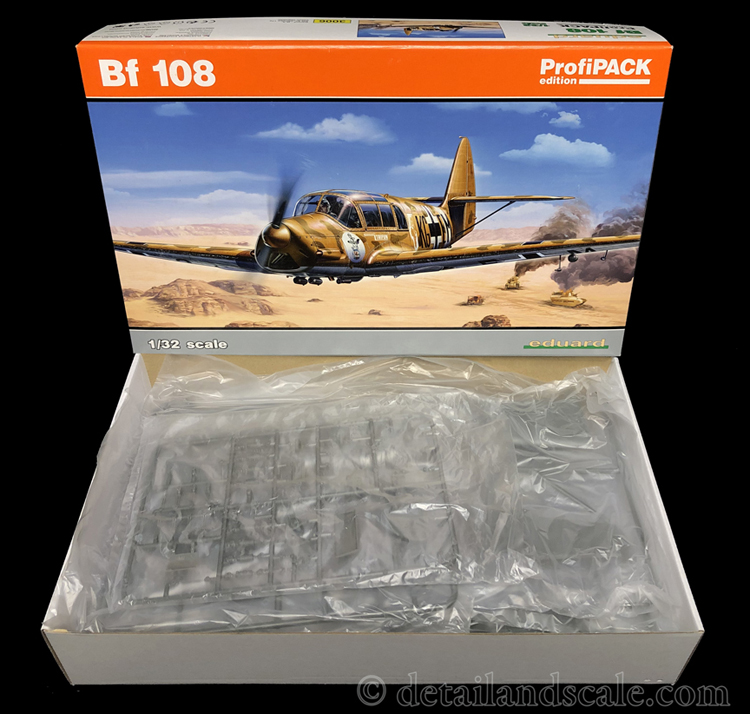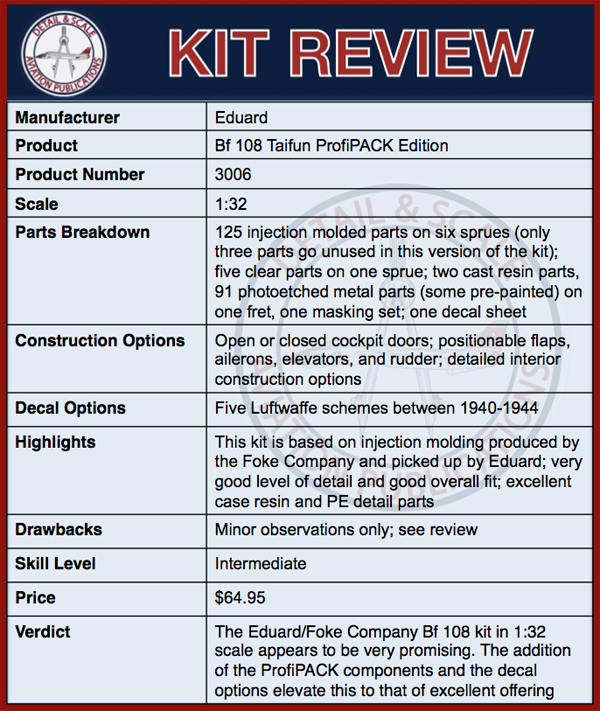Eduard Bf 108 Taifun ProfiPACK Edition –1:32 Scale


The Treaty of Versailles that ended World War I famously barred Germany from developing combat aircraft. Nevertheless, the Germans surreptitiously began a process of rearmament in the 1920s and 1930. Their development of gliders, aerobatic aircraft, and airliners were thinly veiled precursors to the design and manufacturing of high-performance warplanes. The Messerschmitt Bf 108 Taifun was one such sport and touring aircraft developed in the early 1930s. It paved the way for multiple elements of the famous Bf 109 fighter, and itself was used in the war as a liaison and transport platform. Here, Eduard has released a long-awaited 1:32 scale Bf 108 with detail parts, a masking set, and decals for five markings schemes. Let’s check it out.

While initially faced with a total ban on aircraft manufacturing following the end of World War I, Germany was once again allowed to build aircraft under an addendum to the Treaty of Versailles in 1922. A decade later, work started on Messerschmitt’s M 37, itself a derivation of the earlier M 35 aerobatic plane. This was to be a single engine, all-metal sports and recreation aircraft. The M 37 had a single purpose: compete in and win the FAI’s 4th Challenge International de Tourisme in 1934.
The M 37 flew first in early 1934, and soon, it was off to the 1934 sport plane competition held in Poland. Though Polish pilots in a lighter airplane won the contest, the M 37 was a hot rod. German authorities started to produce them in numbers, and the M 37 was re-designated as the Bf 108. The type started to set various performance and endurance records. German aviatrix Elly Beinhorn quite famously flew her personal Bf 108A, which she had named Taifun (or Typhoon), from Berlin to Constantinople in one day. The nickname stuck, and all Bf 108s were then formally designated Taifun.
A total of 885 Bf 108s were manufactured during and even after the war. Most were four-seat Bf 108B-2s and Bf 108D-1s, and they were acquired by the Luftwaffe starting in 1939. These models had a 240 hp Argus As 8C inverted-V piston engine powerplant that drove a two-blade (versus the earlier three-blade) propeller. The tail skid was also replaced by a tailwheel. The Luftwaffe absorbed and integrated Bf 108s into wartime service where they were used for light transport (e.g., personnel), liaison, and air ambulance duty. The extensive Bf 108 service history was complex, as it was also operated Italy, Romania, Japan, Chile, Hungary, Bulgaria, and even by the U.S. Embassy in Berlin. After the war, the French Air Force and Navy continued to operate Bf 108Ds (designated as the Nord 1000) into the late 1950s. Some remain airworthy in private hands today.

Eduard’s ProfiPACK edition of their 1:32 scale Bf 108 contains 125 injection molded parts on six sprues (only three parts go unused in this version of the kit), five clear parts on one clear sprue, two cast resin parts, 91 photoetched metal parts (some pre-painted) on one fret, a pre-cut masking set for the windscreen and canopy, and one decal sheet. The decals sheet features the following five Luftwaffe airframes:
- Bf 108, KG+EM, Sonderkommando Blaich, Tripoli, Libya, January 1942
- Bf 108, BK+ZS, Hungary, 1942-1944
- Bf 108, NF+MS, Stab I./JG51, Soviet Union, Winter, 1942-1943
- Bf 108, 4E+RM, 4.(H)/Aufkl. Gr. 13, Romania, April 1940
- Bf 108, PJ+NG, I./JG 54, France, June/July 1940
Strengths: This kit of the Bf 108 in 1:32 scale is all kinds of interesting. For starters, the plastic is not an Eduard tooling. The plastic was produced a by a little-known kit manufacturer called the Foke Company that makes…industrial robots. Evidently, they did a model kit for fun, and they did a pretty fine job with their Bf 108. Eduard purchased their sprues for this use in this kit.
Parts breakdown is rather conventional and sensible with left and right fuselage halves, upper and lower wing halves, and so forth. I have heard some comments from the online scale model community to indicate that the kit fits rather well, and no major problems, fit conflicts, design errors, or misalignments have been experienced. Further, a good friend of mine is currently building this kit, and they report a problem-free build. Kudos to the Foke Company.
Surface details receive a “very good” rating, with crisp recessed panel lines and fastener/rivet details. Still, many panel lines are a little wide and all the plastic parts have a slightly grainy texture. A little fine sanding or application of a primer should help with both those issues.
The kit features a nice cockpit and there are three different configurations offered for the back seat – one of two differently-sized auxiliary fuel tanks, or a two-passenger bucket seat. Especially if the builder assembles the left and right canopy sides in the open position, they will love what the photoetched metal parts bring to the table. Specifically, they will confer a high level of very visible detail from the instrument panel to gorgeously pre-painted seat belts, and other features from the rudder pedals to knobs, switches, the trim wheel, grab handles, and more. In other words, the plastic parts for the kit are really enhanced by Eduard’s excellent photoetched metal parts in this ProfiPACK edition.
The kit also contains a complete Argus engine that looks great (but for one caveat here; see below). The landing flaps, ailerons, rudder, and elevators are all separate parts and can be positioned as desired. The cast resin prop and spinner are Eduard Brassin castings, and they are flawless.
The decals are printed by Eduard and look great, having excellent color, resolution, and thin, restrained carrier film. The kit comes with great schemes to choose from – diverse colors, locations, and time periods that indeed capture distinct moments in the history of the Luftwaffe’s Bf 108 from northern Africa to the Russian steppes. Also, the pre-cut self-adhesive masking set is a blessing here, especially considering the painting and masking requirements derived from the Bf 108’s big greenhouse style canopy.
Weaknesses: I cannot offer any substantive critiques of this kit (but of course, Bf 108 experts may be aware of minor issues I might not catch). The one big drawback that I can identify is a design consideration. The really neat impressive Argus engine, once built, disappears completely within the engine cowling and there are no provisions to display the engine details. Of course, give a scale modeler a razor saw, and this can be resolved. But before you start cutting, do note that Eduard has released a PE set (# 32452) that provides open engine access doors for 1:32 scale Bf 108.

The Eduard/Foke Company Bf 108 kit in 1:32 scale appears to be very promising. The addition of the ProfiPACK components and the decal options round out an excellent offering. Eduard also offer a pre-painted resin instrument panel in their Löök product line, Brassin wheels and wheel well doors, and more. Have fun with this one, in whatever way you choose to build and paint this kit. Just one final note: by the time this review reaches you, availability of this kit is likely going very limited, owing to the repercussions of the fire at the Eduard warehouse in late December 2020. If you’re in the market for this kit, get one when you can.
Sincere thanks are owed to everyone at Eduard for the review sample. You can visit them on the web at http://www.eduard.com and on Facebook at https://www.facebook.com/EduardCompany.
Haagen Klaus
Scale Modeling News & Reviews Editor
Detail & Scale


